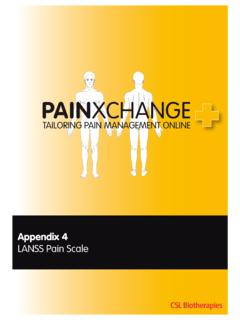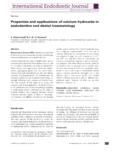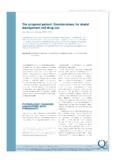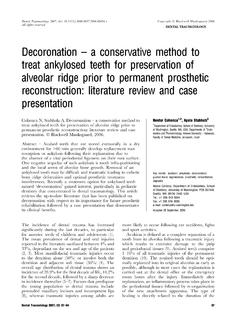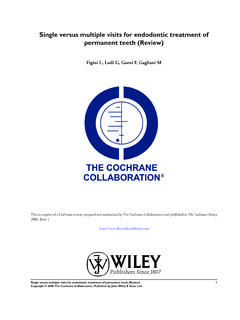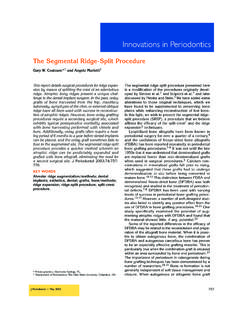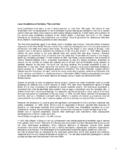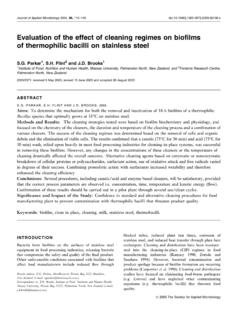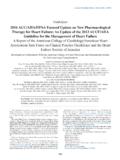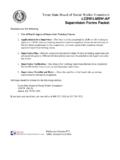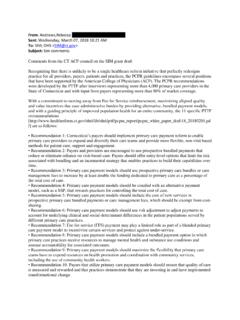Transcription of Current developments in rotary root canal …
1 VOLUME 41 NUMBER6 JUNE2010479 QUINTESSENCE INTERNATIONALThe introduction of nickel-titanium (Ni-Ti) toendodontics almost two decades ago1hasdramatically changed the way root canalpreparation is performed, in both generaland specialist practices. The perceived mostsignificant advantage lies in the predictabilitywith which a desired shape is more important, the use of rotaryinstruments requires attention to detail, eg,regarding the efficacy of antimicrobialregimes that further contribute to successfulendodontic therapy. Then, cases of varyingdegrees of difficulty can be successfully treat-ed, with excellent long-term outcomes (Fig 1).
2 Not every instrument system is suitable forevery clinician, and not all cases lend them-selves to rotary preparation, mainly becauseof varying degrees of experience and com-plexity. Moreover, rotary instruments maybreak rather unexpectedly; if they arecleaned and sterilized for reuse, issues of cor-rosion and persistent contamination maycome into , knowledge ofboth clinical guidelines for and metallurgicalproperties of Ni-Ti rotary instruments is criti-cal for their successful ,4,5A recent sur-vey indicated that US-based endodontists areknowledgeable about Ni-Ti instrument usagebut are still concerned about issues such asbreakage and the quality of the canal , this review is intended to sum-marize most recent trends in Ni-Ti technology,instrument design.
3 And usage is hoped to provide clinicians a knowl-edge base for evidence-based practice, thusmaximizing the benefits from the selection of Ni-Ti rotary instruments for root canal METALLURGY AND MANUFACTURINGN ickel-titanium alloy, first developed for the USNavy,7is in principle highly resistant againstcorrosion, and, more important, it is super-elastic and has a shape memory. The lattertwo properties stem from an atomic arrange-ment that is different from conventional alloyssuch as stainless steel. The atoms in steel canmove against each other by a small specificamount before plastic deformation occurs(Fig 2); in contrast, Ni-Ti exists reversibly in twoconformations, martensite and austenite,depending on ambient temperature (see Fig2a) and external tension (see Figs 2b and 2c).
4 Current developments in rotary root canal instrument technology and clinical use: A reviewOve A. Peters, DMD, MS, PhD1/Frank Paqu , Dr Med Dent2 rotary root canal instruments manufactured from nickel-titanium alloy have proved to be avaluable adjunct for root canal therapy. Over the past two decades, instrument design hasbeen considerably modified; progress has been made in manufacturing, as well as alloyprocessing. Clinical procedures and ideal working parameters are still being refined asnew instruments continue to be introduced to the market. This review is intended to sum-marize clinical and laboratory findings for several Current instruments.
5 Some guidelinesand usage parameters are also detailed. (Quintessence Int 2010;41:479 488)Key words: nickel-titanium, root canal anatomy, root canal preparation, shaping1 Professor and Director of Endodontic Research, University ofthe Pacific, Arthur A. Dugoni School of Dentistry, Department ofEndodontics, San Francisco, California, Professor, University of Zurich Dental School, Divisionof Endodontology, Zurich, :Dr Ove Peters, Department of Endodontics,Arthur A. Dugoni School of Dentistry, University of the Pacific,2155 Webster Street, San Francisco, CA 94115. Fax: 415 929 : 41 NUMBER6 JUNE2010 QUINTESSENCE INTERNATIONALP eters/Paqu Fig 2aTemperature-dependent transition from aus ten itic (brittle, hard)to martensitic (soft) crystalline lattices.
6 Mf, Ms, Af, Asindicate martensiticand austenitic starting and finishing temperatures, 2 Important elements of Ni-Ti 2bForce- and temperature-dependent transitionsfrom austenite to martensite, including the intermediaryR-phase. The proportion of alloy that is in R-phasedepends on heat treatment of the raw 2c Stress-strain diagram (at 51 C) showing the pres-ence of an R-phase (R) in the transition from austenitic (A)to martensitic (M) lattice. The shape of the stress-straincurve depends on ambient temperature and the heattreatment of the raw wire, among other 1 Two clinical cases performed with Ni-Ti rotary instruments (by ).
7 (a to c)Primary root canal treatment of a mandibular molarwith four canals. (d to f)Retreatment of a mandibular molar with three canals. The panels show preoperative radiographs, immediatelypostoperative films, and 4-year recall films, (%)Stress (MPa)R MA RTwinned martensiteDeformed martensiteDeformedR-phaseAusteniteCoolHe at1000 Temperature ( C)Austenite (%)PseudoelasticityMsAfMfAsAmbient temperatureacbdfe2001000 VOLUME 41 NUMBER6 JUNE2010481 QUINTESSENCE INTERNATIONALP eters/Paqu While steel allows 3% elastic deformation,Ni-Ti can withstand deformations of up to 7%without permanent damage or plastic is critical for rotary endodonticinstruments for two reasons.
8 During prepara-tion of curved canals, forces between thecanal wall and abrading instruments aresmaller with more elastic instruments; hence,fewer preparation errors will likely , rotation in curved canals will bendinstruments once per rotation, which will ulti-mately lead to work hardening and brittlefracture, also known as cyclic can withstand up to 20 completebending cycles, while Ni-Ti can be bent up to1,000 difference is related to thedifferent atomic structure of the two alloys, inparticular the transition from austenite tomartensite that occurs in Ni-Ti.
9 The transfor-mation characteristic depends on the ambi-ent temperature and thermal pretreatment ofthe alloy9but usually takes place below tem-peratures in the dental setting so that thealloy is in the austenitic form (see Fig 2a). In addition to the transition from austenite to martensite under load, via twinned marten-site, there is also a transition from the so-called R-phase (see Figs 2b and 2c), atemperature-dependent crystalline structure,to martensite. This transition further con-tributes to the ability of Ni-Ti to absorb stress-es and thus to resist of the instruments described in thissection are manufactured by a grindingprocess, although some are produced by laseretching and others by plastic deformationunder heating.
10 Surface quality is an importantdetail, because cracks can arise from super -ficial defects and may play a role in instrumentfracture10; milled files show characteristicmarks (Fig 3). More dramatic defects such asmetal flash and rollover were common inunused Ni-Ti instruments in the 13 Attempts have been made to improve sur-face quality by a process known as electro-polishing the surface. Electropolishing is anelectrochemical process that reduces sur-face irregularities such as flash and millingmarks (see Fig 3, compare Sequence andGTX files); it is believed to improve materialproperties, specifically fatigue and corrosionresistance; however, the evidence for boththese claims is mixed.
